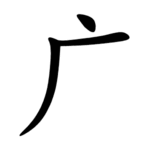广
Appearance
| ||||||||
| ||||||||
Translingual
[edit]| Stroke order | |||
|---|---|---|---|

| |||
| Traditional | 廣 |
|---|---|
| Shinjitai | 広 |
| Simplified | 广 |
Han character
[edit]广 (Kangxi radical 53, 广+0, 3 strokes, cangjie input 卜竹 (YH), four-corner 00200, composition ⿱丶厂(GHTK) or ⿱丨厂(J))
- Kangxi radical #53, ⼴.
Derived characters
[edit]- Appendix:Chinese radical/广
- 疒, 𫩕, 圹, 㚧, 𭚦, 扩, 㲿, 犷, 𨸘, 旷, 𤆓, 矿, 纩, 𧈴, 𧿈, 𬪺, 𠚳, 邝
- 応, 唐, 𢈲, 席, 㐣, 𣒷, 䨾, 鹿, 麻, 䧹, 㥷, 𩾦, 𪎒, 慶, 𢳁, 𢳅, 緳, 𨌱, 𡢦, 𨍗, 𪗆, 𮚥, 𩐕, 𦉨, 𥳁, 䧪, 𤊭, 𦀫, 𨭤
Descendants
[edit]References
[edit]- Kangxi Dictionary: page 343, character 5
- Dai Kanwa Jiten: character 9221
- Dae Jaweon: page 652, character 14
- Hanyu Da Zidian (first edition): volume 2, page 872, character 6
- Unihan data for U+5E7F
Chinese
[edit]Glyph origin
[edit]| Historical forms of the character 广 | ||
|---|---|---|
| Western Zhou | Shuowen Jiezi (compiled in Han) | Liushutong (compiled in Ming) |
| Bronze inscriptions | Small seal script | Transcribed ancient scripts |

|

|

|
Pictogram (象形) : A house with a roof, similar to 宀. According to Wang Yun (王筠), the former character depicts a building with three walls, while the latter depicts a house with four walls.
Unrelated to 床 and 疒, in which it represents a bed. Unrelated to ⼚, which represents a cliff.
Etymology 1
[edit]| For pronunciation and definitions of 广 – see 廣 (“broad; wide; extensive; vast; many; numerous; multitudinous; etc.”). (This character is the simplified form of 廣). |
Notes:
|
Etymology 2
[edit]| For pronunciation and definitions of 广 – see 庵 (“dome-shaped grass house; hut; monastery or nunnery; etc.”). (This character is the former (1935–1936) ROC simplified and variant form of 庵). |
Notes:
|
Etymology 3
[edit]| simp. and trad. |
广 | |
|---|---|---|
Pronunciation
[edit]- Mandarin
- (Standard Chinese)+
- Hanyu Pinyin:
- Zhuyin: ㄧㄢˇ
- Tongyong Pinyin: yǎn
- Wade–Giles: yen3
- Yale: yǎn
- Gwoyeu Romatzyh: yean
- Palladius: янь (janʹ)
- Sinological IPA (key): /jɛn²¹⁴/
- (Standard Chinese)+
- Cantonese
- (Standard Cantonese, Guangzhou–Hong Kong)
- Jyutping: jim2
- Yale: yím
- Cantonese Pinyin: jim2
- Guangdong Romanization: yim2
- Sinological IPA (key): /jiːm³⁵/
- (Standard Cantonese, Guangzhou–Hong Kong)
- Middle Chinese: ngjemX, ngjaemX
- Old Chinese
- (Zhengzhang): /*ŋramʔ/, /*ŋamʔ/
Definitions
[edit]广
References
[edit]Japanese
[edit]Kanji
[edit]广
Readings
[edit]Korean
[edit]Etymology 1
[edit]Hanja
[edit]Etymology 2
[edit]Hanja
[edit]广 (eumhun 넓을 광 (neolbeul gwang))
Etymology 3
[edit]Hanja
[edit]Categories:
- CJK Unified Ideographs block
- Han script characters
- Kangxi Radicals block
- CJKV characters simplified differently in Japan and China
- Han character radicals
- Translingual lemmas
- Translingual symbols
- Han pictograms
- Intermediate Mandarin
- Chinese lemmas
- Mandarin lemmas
- Sichuanese lemmas
- Dungan lemmas
- Cantonese lemmas
- Taishanese lemmas
- Gan lemmas
- Hakka lemmas
- Jin lemmas
- Northern Min lemmas
- Eastern Min lemmas
- Hokkien lemmas
- Teochew lemmas
- Wu lemmas
- Xiang lemmas
- Middle Chinese lemmas
- Old Chinese lemmas
- Chinese hanzi
- Mandarin hanzi
- Sichuanese hanzi
- Dungan hanzi
- Cantonese hanzi
- Taishanese hanzi
- Gan hanzi
- Hakka hanzi
- Jin hanzi
- Northern Min hanzi
- Eastern Min hanzi
- Hokkien hanzi
- Teochew hanzi
- Wu hanzi
- Xiang hanzi
- Middle Chinese hanzi
- Old Chinese hanzi
- Chinese adjectives
- Mandarin adjectives
- Sichuanese adjectives
- Dungan adjectives
- Cantonese adjectives
- Taishanese adjectives
- Gan adjectives
- Hakka adjectives
- Jin adjectives
- Northern Min adjectives
- Eastern Min adjectives
- Hokkien adjectives
- Teochew adjectives
- Wu adjectives
- Xiang adjectives
- Middle Chinese adjectives
- Old Chinese adjectives
- Chinese verbs
- Mandarin verbs
- Sichuanese verbs
- Dungan verbs
- Cantonese verbs
- Taishanese verbs
- Gan verbs
- Hakka verbs
- Jin verbs
- Northern Min verbs
- Eastern Min verbs
- Hokkien verbs
- Teochew verbs
- Wu verbs
- Xiang verbs
- Middle Chinese verbs
- Old Chinese verbs
- Chinese nouns
- Mandarin nouns
- Sichuanese nouns
- Dungan nouns
- Cantonese nouns
- Taishanese nouns
- Gan nouns
- Hakka nouns
- Jin nouns
- Northern Min nouns
- Eastern Min nouns
- Hokkien nouns
- Teochew nouns
- Wu nouns
- Xiang nouns
- Middle Chinese nouns
- Old Chinese nouns
- Chinese proper nouns
- Mandarin proper nouns
- Sichuanese proper nouns
- Dungan proper nouns
- Cantonese proper nouns
- Taishanese proper nouns
- Gan proper nouns
- Hakka proper nouns
- Jin proper nouns
- Northern Min proper nouns
- Eastern Min proper nouns
- Hokkien proper nouns
- Teochew proper nouns
- Wu proper nouns
- Xiang proper nouns
- Middle Chinese proper nouns
- Old Chinese proper nouns
- Chinese terms spelled with 广
- Chinese simplified forms
- zh:Buddhism
- Chinese variant forms
- Chinese terms with IPA pronunciation
- Chinese terms with obsolete senses
- Japanese kanji
- Japanese hyōgai kanji
- Japanese kanji with on reading こう
- Japanese kanji with kun reading ひろ
- Korean lemmas
- Korean hanja
- CJKV simplified characters which already existed as traditional characters
